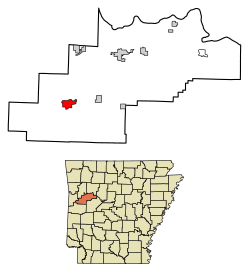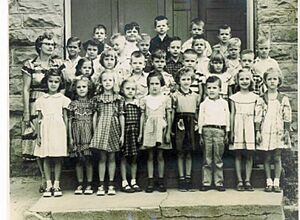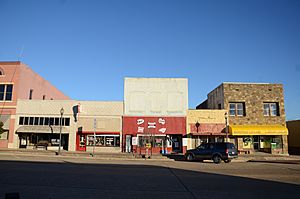Booneville, Arkansas facts for kids
Quick facts for kids
Booneville, Arkansas
|
|
|---|---|

Booneville commercial downtown district
|
|

Location of Booneville in Logan County, Arkansas.
|
|
| Country | United States |
| State | Arkansas |
| County | Logan |
| Established | 1828 |
| Incorporated | 1878, 1899 |
| Area | |
| • Total | 3.96 sq mi (10.26 km2) |
| • Land | 3.94 sq mi (10.21 km2) |
| • Water | 0.02 sq mi (0.05 km2) |
| Elevation | 482 ft (147 m) |
| Population
(2020)
|
|
| • Total | 3,809 |
| • Density | 965.77/sq mi (372.92/km2) |
| Time zone | UTC−06:00 (Central (CST)) |
| • Summer (DST) | UTC−05:00 (CDT) |
| ZIP Code |
72927
|
| Area code(s) | 479 |
| FIPS code | 05-07720 |
| GNIS feature ID | 2403896 |
Booneville is a city in Logan County, Arkansas, United States. It is one of the two county seats for Logan County. The city is located in the Arkansas River Valley, between the Ouachita and Ozark Mountains. It is one of the oldest cities in western Arkansas.
Booneville's economy first grew because of the railroad and a special hospital called the Arkansas State Tuberculosis Sanatorium. Today, it has many small businesses and light industries. In 2010, about 3,990 people lived in Booneville.
The city has a community center, a senior-citizens center, a hospital, a small airport, and modern school buildings. You can enjoy outdoor activities like hunting, fishing, camping, and hiking in the nearby national forests and state parks.
Contents
History of Booneville
How Booneville Got Its Name
Booneville was started in 1828 by Walter Cauthron. He was an early explorer of the Arkansas Territory. He built a log cabin and a store near the Petit Jean River.
Some people say he wanted to name the town "Bonneville" after his friend Benjamin Bonneville. But the spelling and name changed later. Another idea is that the town was named after Daniel Boone. He was a friend of the Logan family, who the county is named after.
Fire at a Meat Plant in 2008
On March 23, 2008, a fire happened at the Cargill Meat Solutions plant in Booneville. This fire caused several explosions. No one was hurt in the accident.
The fire started by accident when workers were doing repairs on fans in a freezer area. At that time, the Cargill Meat plant was the biggest employer in Booneville.
Booneville's Geography
Booneville covers about 4.1 square miles (10.6 square kilometers) of land.
The city is close to Blue Mountain Lake. This lake is a popular spot for fishing, boating, and swimming. There are five public areas managed by the United States Army Corps of Engineers where people can access the lake.
At the east end of the lake, you'll find the Blue Mountain Wildlife Demonstration Area. This is a great place for training bird dogs. Visitors also come here for hiking, bird watching, and mountain biking.
Booneville's Climate
| Climate data for Booneville, Arkansas (1991–2020 normals, extremes 1915–present) | |||||||||||||
|---|---|---|---|---|---|---|---|---|---|---|---|---|---|
| Month | Jan | Feb | Mar | Apr | May | Jun | Jul | Aug | Sep | Oct | Nov | Dec | Year |
| Record high °F (°C) | 84 (29) |
87 (31) |
94 (34) |
96 (36) |
99 (37) |
111 (44) |
114 (46) |
118 (48) |
112 (44) |
100 (38) |
89 (32) |
83 (28) |
118 (48) |
| Mean daily maximum °F (°C) | 50.0 (10.0) |
55.2 (12.9) |
63.5 (17.5) |
72.5 (22.5) |
79.5 (26.4) |
87.2 (30.7) |
92.1 (33.4) |
91.9 (33.3) |
84.8 (29.3) |
74.5 (23.6) |
62.2 (16.8) |
52.4 (11.3) |
72.1 (22.3) |
| Daily mean °F (°C) | 39.0 (3.9) |
43.1 (6.2) |
51.0 (10.6) |
59.8 (15.4) |
68.6 (20.3) |
76.6 (24.8) |
81.0 (27.2) |
80.1 (26.7) |
73.0 (22.8) |
62.0 (16.7) |
50.2 (10.1) |
41.5 (5.3) |
60.5 (15.8) |
| Mean daily minimum °F (°C) | 28.0 (−2.2) |
31.1 (−0.5) |
38.5 (3.6) |
47.2 (8.4) |
57.7 (14.3) |
65.9 (18.8) |
69.9 (21.1) |
68.4 (20.2) |
61.3 (16.3) |
49.5 (9.7) |
38.1 (3.4) |
30.7 (−0.7) |
48.9 (9.4) |
| Record low °F (°C) | −18 (−28) |
−6 (−21) |
5 (−15) |
22 (−6) |
30 (−1) |
45 (7) |
49 (9) |
41 (5) |
32 (0) |
18 (−8) |
8 (−13) |
−9 (−23) |
−18 (−28) |
| Average precipitation inches (mm) | 3.75 (95) |
3.20 (81) |
4.78 (121) |
5.04 (128) |
5.82 (148) |
4.24 (108) |
3.56 (90) |
3.49 (89) |
4.39 (112) |
4.40 (112) |
4.62 (117) |
4.35 (110) |
51.64 (1,312) |
| Average precipitation days (≥ 0.01 in) | 7.6 | 7.6 | 9.5 | 8.7 | 10.4 | 8.0 | 8.1 | 7.0 | 7.2 | 7.9 | 8.0 | 7.9 | 97.9 |
| Source: NOAA | |||||||||||||
Booneville's People
How Many People Live Here?
| Historical population | |||
|---|---|---|---|
| Census | Pop. | %± | |
| 1880 | 275 | — | |
| 1890 | 496 | 80.4% | |
| 1900 | 988 | 99.2% | |
| 1910 | 1,631 | 65.1% | |
| 1920 | 2,199 | 34.8% | |
| 1930 | 2,099 | −4.5% | |
| 1940 | 2,324 | 10.7% | |
| 1950 | 2,433 | 4.7% | |
| 1960 | 2,690 | 10.6% | |
| 1970 | 3,239 | 20.4% | |
| 1980 | 3,718 | 14.8% | |
| 1990 | 3,804 | 2.3% | |
| 2000 | 4,117 | 8.2% | |
| 2010 | 3,990 | −3.1% | |
| 2020 | 3,809 | −4.5% | |
| U.S. Decennial Census 2014 Estimate |
|||
This table shows the different groups of people living in Booneville.
| Race | Number | Percentage |
|---|---|---|
| White (non-Hispanic) | 3,346 | 87.84% |
| Black or African American (non-Hispanic) | 22 | 0.58% |
| Native American | 61 | 1.6% |
| Asian | 24 | 0.63% |
| Pacific Islander | 1 | 0.03% |
| Other/Mixed | 218 | 5.72% |
| Hispanic or Latino | 137 | 3.6% |
In 2020, there were 3,809 people living in Booneville. They lived in 1,439 households, and 855 of these were families.
Education in Booneville
Booneville has always cared about education. In 1874, a school called the Fort Smith District High School was started in Booneville. It was for students who wanted more advanced learning in western Arkansas.
Local church members helped build the school by donating land, materials, and their time. Students paid tuition fees to attend. Kids from all over western Arkansas came to Booneville to live with families and go to this school. It taught subjects like Latin, German, advanced math, literature, and music. This school operated until the early 1900s.
After that school closed, a group of local people started the Booneville Education Association. They bought 9 acres (3.6 hectares) of land and built a new school called the Booneville Co-Educational Institute. This school also offered more advanced classes than the public schools. Students who graduated from here could enter the University of Arkansas at Fayetteville as sophomores.
In 1920, the state began providing money for public high schools. The Co-Educational Institute's property was then given to the Booneville School District. The building was used as the city's high school until a new one was built in 1929. For many years after that, the old Co-Educational Institute building became the Booneville elementary school.
Booneville's Infrastructure
Getting Around Town
Booneville is located where Highway 23 (also known as the "Pig Trail") and Highway 10 meet. Both of these roads are special "Scenic Byways" near Booneville, meaning they offer beautiful views. Highway 217 also goes north and south from the city.
The streets in downtown Booneville were planned to be wider than in most towns. This makes it easier to get around.
Water and Wastewater
The city of Booneville has its own Water Department. This department cleans water from Lake Booneville and sends it to homes and businesses in the city. They make sure the water is safe to drink.
The Water Department also collects and cleans wastewater from the city. After it's cleaned, the treated water goes into Booneville Creek, which eventually flows into the Arkansas River.
Famous People from Booneville
Many notable people have connections to Booneville:
- Dizzy and Daffy Dean were brothers and famous Major League Baseball (MLB) players. They were born in a small community called Lucas, about 14 miles (23 km) west of Booneville.
- Kimberly Foster is a television and movie actress. She is well-known for playing Michelle Stevens in the TV show Dallas.
- Elizabeth Ward Gracen was Miss America 1982. She also acted in the TV show Highlander: The Series.
- John P. McConnell was the chief of staff of the United States Air Force from 1965 to 1969.
- Floyd Speer was a pitcher for the Chicago White Sox. He played in MLB from 1943 to 1944. He is buried in the Carolan Community Cemetery.
- Aaron Lee Ward was a baseball player. He was part of the New York Yankees team that won their first World Series championship in 1923.
- Paul X. Williams was a federal judge for the Western District of Arkansas. He was chosen for this role by President Lyndon B. Johnson.
See also
 In Spanish: Booneville (Arkansas) para niños
In Spanish: Booneville (Arkansas) para niños



